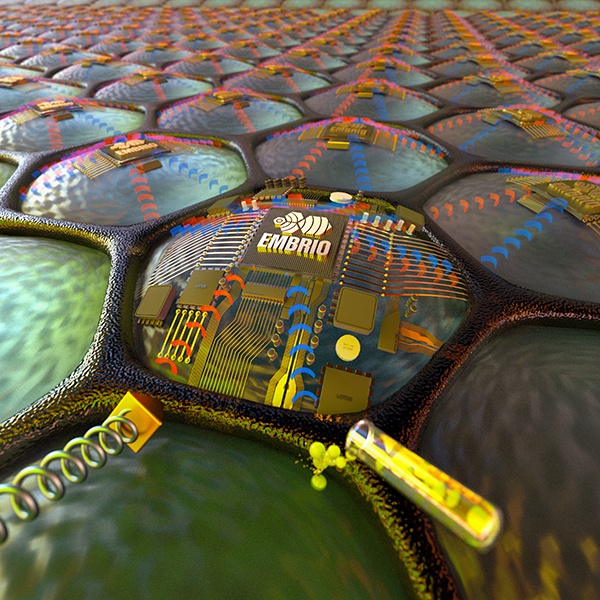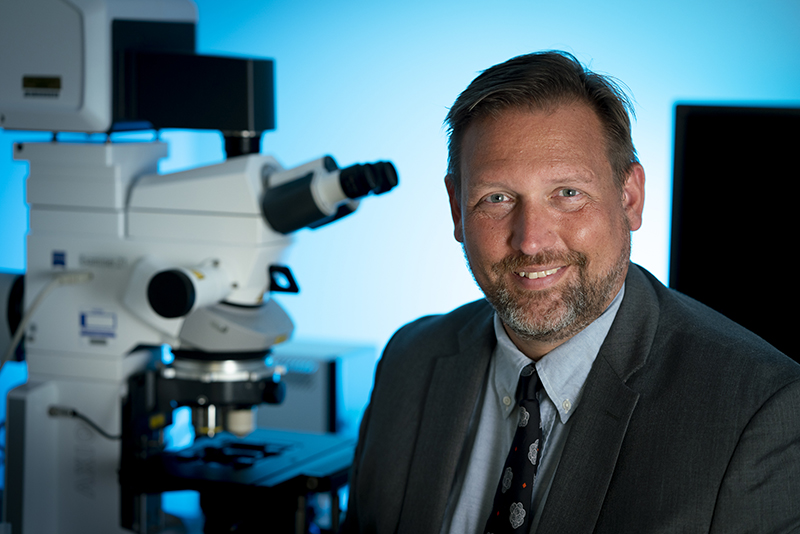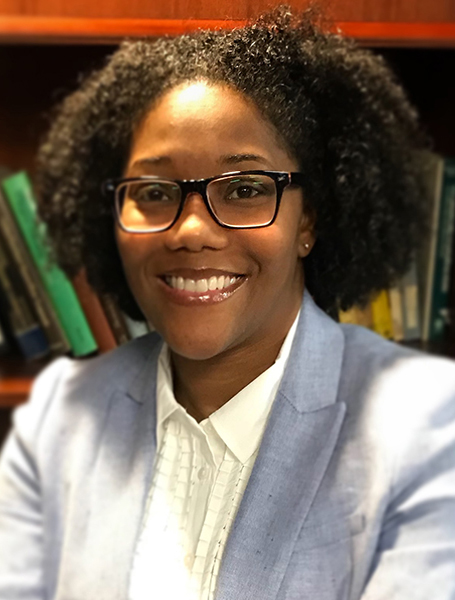October 5, 2021
Cracking the code of cellular defense

Purdue University will serve as the main site of the new Emergent Mechanisms in Biology of Robustness, Integration and Organization (EMBRIO) Institute. The institute, which will use AI to expand biology and engineering, has received $12.5 million from the National Science Foundation over five years as part of the agency’s Biology Integration Institutes program. (EMBRIO illustration by Second Bay Studios. Courtesy of Purdue University.)
WEST LAFAYETTE, Ind. — Imagine the day when any tissue or organ can be repaired or the replacements personalized to the patient.
That’s one of the goals of work being done by David Umulis of Purdue University and a team of scientists using artificial intelligence in biology to see how cells defend themselves from chemical or mechanical attack and/or repair their damage with the help of biochemical and mechanical inputs and reactions.
If this is successful, Umulis says, scientists could have a new way to address human health and longevity.
“If you can touch a network and modify three or four locations at once, the capability to treat diseases or damage will improve as you are signaling all these different biological pathways simultaneously,” he says.
 David Umulis, EMBRIO project director, professor and the Dane A. Miller head of Purdue University’s Weldon School of Biomedical Engineering. (Purdue University photo)
Download image
David Umulis, EMBRIO project director, professor and the Dane A. Miller head of Purdue University’s Weldon School of Biomedical Engineering. (Purdue University photo)
Download image
Unlocking new potentials
Umulis uses AI in several of his biomedical engineering projects, including quantifying images and simulating developing cells. He finds that it provides results better, earlier and faster, and can be inexpensive compared with many hours simulating cell features.
But he wants to innovate and push further. The new Emergent Mechanisms in Biology of Robustness, Integration & Organization (EMBRIO) Institute will use AI to expand biology and engineering through exploring how cell signals are integrated to fight off invaders or activated to repair wounds, which are both essential to survive.
“I want the EMBRIO Institute team to be known as the research team that cracked the code on how cells organize to change structure function for defending and repairing tissues,” says Umulis, EMBRIO project director, professor and the Dane A. Miller head of Purdue’s Weldon School of Biomedical Engineering. “The network where the cells make those decisions and how it is copied and replicated throughout the animal kingdom is still a big mystery. The integration of laboratory experimentation with the simulation and data acquisition approach that we have is really the best way to address such a large-scale fundamental biological processing question.”
Purdue serves as the main site for the EMBRIO Institute, which has received $12.5 million from the National Science Foundation (NSF) over five years as part of the agency’s Biology Integration Institutes (BII) program. The partner institutions are Indiana University, Morehouse College, the University of Notre Dame, University of Pennsylvania, the Ponce (Puerto Rico) Health Sciences University and the University of Puerto Rico at Mayagüez. Morehouse, Ponce and Mayagüez are essential to expanding the contributions of traditionally underrepresented populations throughout the EMBRIO Institute.
“The EMBRIO Institute exemplifies the goals of the BII program by bringing together an interdisciplinary team of researchers around the common goal of understanding how the processes that sustain life and enable biological innovation operate and interact within and across different scales,” says Wilson Francisco, Ph.D., program director in the Directorate for Biological Sciences at the NSF. “It will also provide effective new training paradigms that are inclusive and prepare the next generations of scientists to navigate diverse fields in the biological sciences and STEM broadly. By combining experimental biology, theory, computation and modeling, alongside training and education of a diverse group of students, EMBRIO holds the potential to advance biology, biotechnology and the biological sciences workforce.”
As director, Umulis will coordinate and empower researchers and students to find new ways to use AI in cracking cellular organization.
“We can do a lot more with a lot less,” he says. “That allows us to think about addressing how cells are computing and then how cells are coupled, leading to tissue changes at this massive scale.”
With AI, Umulis and scientists are able to use full 3D simulations of biological structures to establish predictive capabilities. This allows them to see how the shape of networks and tissues can change.
They can then link different biological systems together – such as cell chemistry and chemical signaling, and mechanics and mechanical changes – to better predict outcomes in more complex systems.
“We are getting to a point where we know how a tissue grows, shapes and forms into something that has the right structure and function based on the genotypes, the genetics and the signaling pathways,” Umulis says. “Biology is able to use all these things synchronously during stages of life and development. The way they do it is an amazing synchrony that can only be tapped through the combination of simulation and AI.”
EMBRIO’s biological systems group acquires data for simulations immediately – such as a plant fighting off invading fungi or such as the tens of thousands of cells signaling each other to heal a wound. However, developing models to fuse the various discoveries will take time.
“We’re going to use each biological system for the best data acquisition that we can get so that we are able to answer how cells respond together to fight off would-be attacks. How are wounds closed? How can we accelerate that? How do cells orchestrate processes of tissue remodeling for embryo development or to repair and restore cell, tissue or organ function? This is the most important part for life,” he says.
 Juana Mendenhall, the Walter E. Massey Professor of Physical Sciences at Morehouse College. (Photo provided)
Download image
Juana Mendenhall, the Walter E. Massey Professor of Physical Sciences at Morehouse College. (Photo provided)
Download image
Building on strengths in AI and biomedical engineering
The AI and biology industry doubles in size every five years, meaning the biology, engineering and science students coming into EMBRIO now will be the cutting-edge leaders over the next 10 years, Umulis says.
Umulis has gathered a team of specialized engineers and scientists who, in turn, will work with and inspire students of these new techniques and address future workforce development needs.
One of the institution partners involved is Morehouse College, a liberal arts historically Black college and university (HBCU) in Atlanta.
Juana Mendenhall, the Walter E. Massey Professor of Physical Sciences at Morehouse College, is one of the research partners who will be conducting research within the EMBRIO Institute in her Morehouse laboratory. She brings expertise in materials chemistry and fabrication along with nanobiotechnology using atomic-force microscopy to investigate biology processes to the project.
In addition to the core research that Mendenhall will conduct with the institute, she also sees many positives for her students. They’re able to gain experiential opportunities by enhancing their lab techniques and learning new software for computational modeling and data science visualizations that will help them develop as scientists, she says.
“The ability to engage and train HBCU students in AI at the intersection of STEM while employing methods used in biology and biomedical engineering is needed for our students at Morehouse,” Mendenhall says. “Our students need to see the synergy between the natural sciences, life sciences and engineering.
“In collaboration with Purdue, Morehouse will have access to cutting-edge technology and tools to help study these processes. This will further enhance our students’ knowledge and exposure to the emerging field of integrative biology.”
Umulis and EMBRIO leaders also plan to use existing open-source programs but will develop additional AI and biological programs for students.
Additional PIs are Janice Evans, Chris Staiger, Stephanie Gardner and Alejandra Magana (Purdue), and site leaders Mauricio Cabrera (University of Puerto Rico at Mayagüez), James Glazer (IU), Clara Isaza (Ponce Health Sciences University), Mary Mullins (Penn), and Jeremiah Zartman (Notre Dame).
Writer, Media contact: Matthew Oates, 765-586-7496 (cell), oatesw@purdue.edu, @mo_oates
Sources: David Umulis, dumulis@purdue.edu
Juana Mendenhall, juana.mendenhall@morehouse.edu
Note to journalists: An illustration and images of David Umulis and Juana Mendenhall are available via Google Drive. Journalists visiting campus should follow visitor health guidelines.

